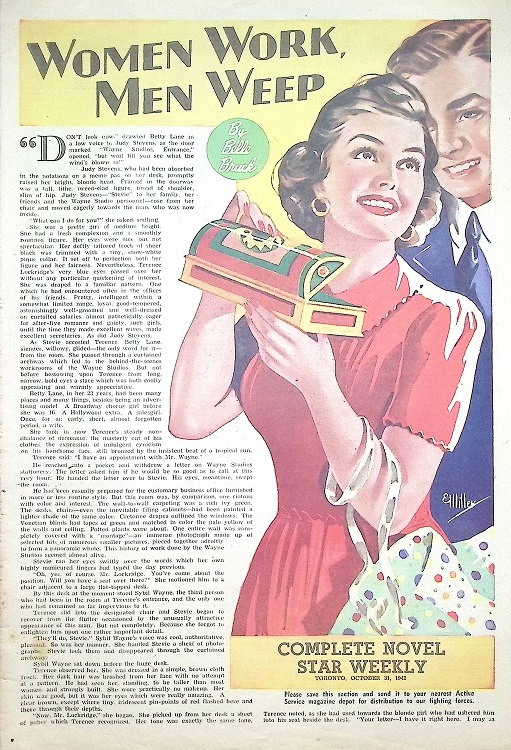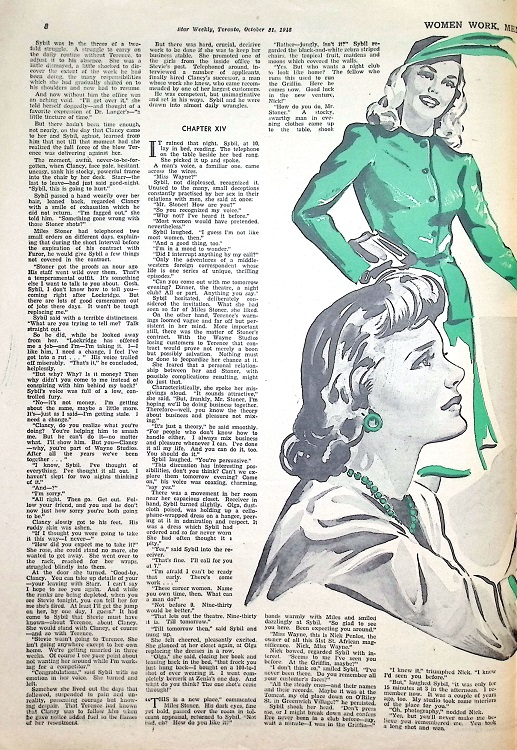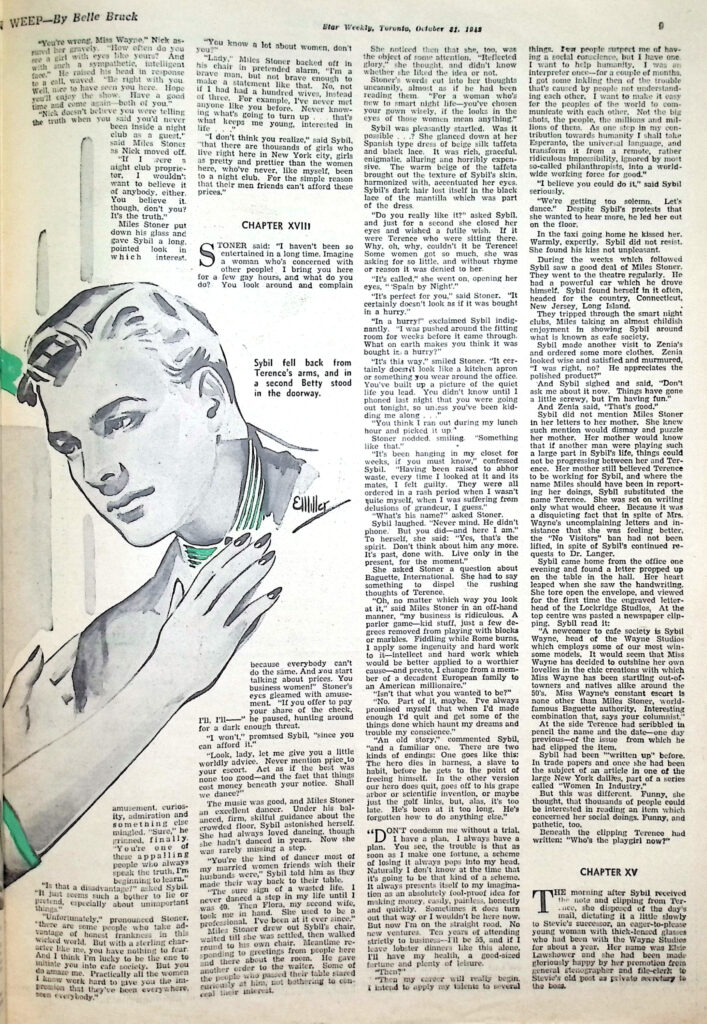
Circa 1942, mid-WWII and the same year “Rosie the Riveter” was launched, this newsprint novel seemed certain to explore male anxieties around women arriving in the workplace. Based on the delicious title, I had hopes of fierce female characters trampling upon the pathetic squabbles of men who simply cannot handle co-ed colleagues and bosses. Might this be a lost masterpiece of early feminism?
My expectations were too high, but the story does illustrate the dizzying lengths a 1940s man might go to avoid having a female superior. Sadly she falls for the scheme and, in the end, gives up her entrepreneurial dreams to become a wife. The plot is a nauseating cringe-fest for modern audiences, but that’s not to say the writing is bad or it’s not intriguing from an historical perspective.
The story opens with Terence Lockridge arriving for a job interview at a photography studio. He is confused when a woman enters the room and asks her to fetch “Mr. S. Wayne” for their appointment. She explains that there is no Mr. S. Wayne. The “S” stands for Sybil.
Terence apologies for his confusion, but it’s clear he remains uncomfortable with the situation. If he weren’t so desperate he would walk right out the door. Previously money was plentiful from his father’s fortune. Now that Dad is dead, Terence finds himself with no prior experience and only a willingness to learn.
She, meanwhile, tells how she is the daughter of immigrants who has worked all her life to survive. She struggled and struggled, but eventually found herself here—president of this successful company.
Despite having more-qualified candidates in queue, Sybil sees something in Terrence—likely his hunky “sunburned playboy” physique—and offers him the position.
“If you turn down the job,” she says, “I’ll understand perfectly. I know there are some men who just can’t bear the thought of working under the direction of a woman.”
“I’m afraid I’m one of them,” acknowledges Terence. “If I could afford that luxury, I admit I would still indulge in it. But I can’t afford it, so—I’ll take the job—and thanks.”
And thus launches into motion a “love story” between the empowered Sybil and the pathetic scum that is Terence. So cute—NOT. But I try to remember this is the 1940s and read on. Maybe she’ll turn dominatrix and whip him into shape?
Not quite. As their sexual tension increases, we learn more about the source of Terence’s misogyny. His late father “employed thousands of men and not a single woman.” Terence makes it clear he agrees with this policy, believing “a man should take care of his women.”
To her credit, Sybil says his dead father must’ve been a “dictatorial, opinionated, conceited, hard-hearted person” that she wouldn’t have liked.

Even still, her affection for Terence increases. His performance at the office is quite good. New clients pour in and there’s a boom unlike the company has seen before. He learns quickly from Sybil and eagerly takes control of a project. Soon she feels like she hardly has to do her job anymore.
With extra free time, Sybil begins to think even more about love. Having worked all her life, she never found time for herself—to dress up or consider romantic pursuits. She enlists the support of Zenia, a fashionista who talks her into an expensive makeover. Sybil returns to the office looking like a bombshell. She’s hot, her new employee is hot, and business is good. What could go wrong?
Well, trouble comes down fast and furious. Terence announces that he’s quitting to start a photography business of his own. Furthermore, he talked Sybil’s entire staff into going along with him. Now former clients are following the talent and abandoning Sybil’s company for Terence’s.
Betrayed and heartbroken, Sybil’s one hope is securing a big contract with a board game mogul. He’s an older man, attractive and kind, but also still married to his third wife. He invites Sybil out dancing and soon tabloids notice that she’s been seen with a married man. She tries to brush this off. He’s a nice guy and she feels it’s important to stay friendly until the contract is signed. Without it, she may go out of business.
This friendship is soon complicated by the mogul’s vindictive wife, however, and when Sybil agrees it’s best for their social life to end, so goes the contract. Terence, of course, is right there and aggressively moves in to steal the job.
With ever-increasing fury toward Terence, she is extra appalled when he calls requesting to buy out her business. In a reverse of their first meeting she, desperate, reluctantly agrees to hear his offer. It’s a fair price. She feels she has no option but to take it.
Though at this point it seems that Terence is a monster, even if a hot one, there is a “twist” at the end where it is revealed he went through all this hassle for love. He became an expert in photography studios, started his own business, and hijacked her contracts all with the hope of her near-bankruptcy not because he didn’t like her, but because he wanted to marry her. With her out of a job, he can fulfill the family philosophy that a man’s role is to care for his woman. Sybil’s ambitions can now be sufficiently confined to staying home and looking pretty.
I guess this is supposed to be romantic???
My hope, of course, is that Sybil will smash a lamp over his head and push him into oncoming traffic. But no, she agrees to marry him. Worse still, the ending image is of Terence helping his over-excited bride-to-be fall asleep by mixing a powder into her drink.
And then they lived happily ever after? That’s the implication, but… eek!

My immediate reaction to the ending was revulsion and horror, particularly in knowing that the author was a successful businesswoman herself. I had to take a breath, remind myself that this was 1942, and that Bruck had a delicate dance to play. The reality is that if Sybil had been a strong feminist character satisfactory to today’s desires, the story would likely have gone unpublished. It might even be considered too “shocking” for public consumption and promptly banned.
Also, perhaps the “message” of the novel isn’t quite as appalling as I originally thought. Terence argues: “I destroyed your career, but I don’t believe that making money is your career.” While this line seems like a violent misunderstanding of Sybil’s character—she appears most happy when she is thriving in a business environment—in the end, she reflects that he is possibly right. Maybe there is more to life than making money, and maybe this is an opportunity for her to use her talents for other purposes.
As with any oppressed population, gaining equality can result in new challenges. The obsession to prove that women can be as successful as men causes Sybil to miss out on other aspects of life. This got me thinking about when same-sex marriage became legal. There was immense pressure for these marriages to appear perfect. After a while, reality sits in that gay marriage also means gay divorce. When you’ve fought for the legal right, maybe even lost family over it, it can be very hard to admit defeat. But sometimes admitting defeat is the right decision.
Sybil giving up her dreams seems so disappointing after all the work she did to get there, but who’s to say she won’t be happier letting Terence run the studio instead? Maybe she has other dreams, bigger dreams, to fulfill?
The point is, being an entrepreneur is wonderful, but so is being something else. For example, stay-at-home moms and dads are just as important as career dudes and ladies. Maybe I shouldn’t judge her for choosing happiness, even if it’s not the path I would like to see.
Or maybe she’s been brainwashed by the patriarchy and will be hellishly miserable every living moment she spends with the piece of shit misogynist. That’s still the more likely scenario, I think, but hey—everybody’s got to make mistakes to learn. No shame in that either.
PUBLISHING HISTORY
Women Work, Men Weep has an interesting publishing history in that it was never published. At least not in book form. It originally appeared as a “Weekly Novel” in the Toronto Star. Printed on extra-large, four-column newspaper, the entire 40,000ish word text is crammed into only fifteen pages. Many novels published in the Toronto Star eventually appeared as hardcovers or paperbacks, but this one wasn’t. It was re-printed at least one other time, also in newsprint, in Maine’s Bangor Daily News.
Possibly the title was inspired by an article featured in the April 18, 1925, issue of the Winnipeg Tribune. The article, also titled “Women Work, Men Weep,” reports on the “invasion” of women in the workforce and brings dire breaking news that not a single industry is immune to their presence now. Dun dun dun!
ABOUT THE AUTHOR
I found no books credited to Belle Bruck, however she was responsible for hundreds of short stories and articles. The vast majority appeared in newspapers. Some titles include “The Girl Between” (1944), “Another Nora” (1942), “Local Girl Makes Good” (1944) and “This Time It’s Different” (1942).
Here’s the transcription of one “about the author” profile from 1942:
Belle Bruck, who makes her debut as a novelist with this story [Women Work, Men Weep], although she has written plenty of short fiction as a warm-up, is a native New Yorker who confesses to a horror of small towns.
“I am a native provincial New Yorker,” she says. “For me there is no place like New York and no place in New York like Greenwich Village.”
She interests herself in politics, local, national, and international, in dancing and in ping-pong. Right now the war—and ways of winning it fast—holds her attention as it does that of millions of her fellow Americans.
Miss Bruck has worked in an advertising agency, and as the editor of an international digest magazine, in addition to turning out feature articles and fiction on her own.
No doubt this fascinating author has plenty more history to unearth should someone choose to dig. Though her novel has not aged well, it was still the product of a trailblazer and should not be forgotten.
Don’t miss our latest content! SpookyBooky is on social media:
